2022-2023 Community Homelessness Report
Summary of the annual Reaching Home report.
The Community Homelessness Report (CHR) is an annual Reaching Home reporting deliverable that supports communities to prevent and reduce homelessness using a more coordinated, systems-based, and data-driven response. The CHR was designed to support local discussions and decision-making, using all of the information about homelessness currently available at the community level. Communities are encouraged to use their CHR data to develop clear plans of action that help them to reach their homelessness reduction targets and to leverage the collective efforts of service providers working across the community, regardless of how they are funded.
This is a summary of the CHR for the 2022-23 reporting cycle. It shows the community’s self-assessment of Reaching Home implementation, which includes the following key components:
- Meaningful collaboration between Indigenous and non-Indigenous partners (see Section 1)
- Community-level governance, coordinated service delivery (Coordinated Access) and use of a Homelessness Management
- Information System or HMIS (see Section 2); and,
- An outcomes-based approach (tracking community-level outcomes and progress against targets using a Unique identifier or By-Name List, referred to as a List; see Section 3).
- If the community was able to report on outcomes and targets, this CHR Summary also includes results for each of the five core outcomes of Reaching Home (see Section 4).
Section 1: Community context - collaboration between Indigenous and Non-Indigenous partners
Does your community, as a Designated Community (DC), also receive Reaching Home Indigenous Homelessness (IH) funding?
No – only DC funding is available.
Specific to Coordinated Access and the HMIS, has there been ongoing, meaningful collaboration between the DC or Territorial Homelessness (TH) CE and local Indigenous organizations over the reporting period?
No.
Describe how this collaboration will happen over the coming year in more detail.
We recognize that Indigenous people are overrepresented amongst the homeless population and recognize the impact that colonization, intergenerational trauma, and residential schools have had on Indigenous people.
We work with organizations that ensure that Indigenous people in the shelter are offered a connection to culturally specific supports.
We will continue to refer to local resources such as The Indigenous Network, Na Mes Res, and Metis Nation.
Connection with the non-designated Community Entity at United Way Simcoe Muskoka has been made and information and support for us to move forward with has been provided.
Next, we will be connecting with Aboriginal Labour Force Development Circle to obtain further support on how we can make a better connection with Indigenous Organizations in Peel and involve them in our work for the homeless community.
We endeavour to have Indigenous Organizations participating and contributing to our Coordinated Access system.
With respect to the completion of the Community Homelessness Report (CHR), was there ongoing, meaningful collaboration between local Indigenous and non-Indigenous organizations and, where applicable, the IH CE and/or IH CAB?
No.
What is the plan to ensure meaningful collaboration occurs during next year’s CHR process?
In our endeavour to create meaningful relationships with Indigenous organizations, we hope to add to our CAB an Indigenous individual that can enrich the knowledge and experience of our current CAB.
We will discuss how to collaborate and involve Indigenous organizations at our CAB meetings in the hopes that we can engage Indigenous peoples in the work that we are doing.
We will share with them previous CHR’s and discuss with them the programs and services that the Region is currently supporting.
We will involve them in our Reaching Home application and program discussions.
We will discuss how to collaborate and involve Indigenous organizations at our CAB meetings in the hopes that we can engage Indigenous peoples in the work that we are doing, including on the CHR.
Section 2. Coordinated access and Homelessness Management Information System (HMIS) self-assessment
The table below provides a summary of the work your community has done so far to meet the Reaching Home minimum requirements for Coordinated Access and an HMIS.
| Met | Started | Not yet started | |
|---|---|---|---|
| Number of minimum requirements | 18 | 0 | 0 |
The table below shows the percentage of minimum requirements completed for each core Coordinated Access component.
| Governance | HMIS | Access Points to Service | Triage and Assessment | Coordinated Access Resource Inventory | Vacancy Matching and Referral |
|---|---|---|---|---|---|
| 100% | 100% | 100% | 100% | 100% | 100% |
Summary comment
Are there particular efforts and/or issues that you would like to highlight for this reporting period related to your community’s work to achieve the Reaching Home minimum requirements?
The 2022-2023 fiscal year marks Peel Region's milestone of meeting minimum requirements under the Reaching Home Coordinated Access Directive. As well, our community received confirmation from the Canadian Alliance to End Homelessness for meeting Reaching Home level in our Coordinated Access scorecard, through the completion of the Provider Participation Tool and Coordinated Access Initial Written Documents Checklist.
The policies and procedures outlined in our Coordinated Access guide were updated in accordance with the proponents of a quality Coordinated Access system. A Housing Resource Inventory was created which lists the agency/program name, eligibility, and approximate number of housing resources.
Our community participated in the Action-Oriented Case Conferencing Cohort (AOC3) with Built for Zero to test and improve elements of action-oriented case conferencing toward community reductions in chronic and/or veteran homelessness. The Adult Case Conferencing Table was relaunched and meets biweekly alongside the Youth Case Conferencing Table. The Data Sharing Agreement was shared with service providers for review and with the opportunity to provide feedback. Due to the delay in achieving a completed Data Sharing Agreement, Coordinated Access in Peel cannot be administered through the HMIS and our community continued to use the interim process while awaiting the finalization of the data-sharing agreement. Nine households from the BNL successfully became housed after being selected using prioritization criteria and offered affordable housing resources funded by Reaching Home.
Section 3. Outcomes-based approach self-assessment
Summary tables - minimum requirement
The tables below provide a summary of the work your community has done so far to transition to an outcomes-based approach under Reaching Home.
| Step 1: Has a List | Step 2: Has a real-time List | Step 3: Has a comprehensive List |
|---|---|---|
| Yes | Yes | Yes |
Step 4: Can report monthly outcomes and set targets using data from the List (reporting in Section 4 is mandatory for 2023-24 CHRs, if not earlier)
| List was in place as of January 1, 2023 (or earlier) | Can generate monthly data | Has set targets | Has an outcomes-based approach in place | Yes | Outcome 1: Yes | Outcome 1: Yes | Yes |
|---|---|---|---|
| Outcome 2: Yes | Outcome 2: Yes | ||
| Outcome 3: Yes | Outcome 3: Yes | ||
| Outcome 4: Yes | Outcome 4: Yes | ||
| Outcome 5: Yes | Outcome 5: Yes |
Step 4: Can report annual outcomes and set targets using data from the List (reporting in Section 4 is mandatory once annual data can be generated)
| List was in place as of April 1, 2022 (or earlier) | Can generate monthly data | Has set targets | Has an outcomes-based approach in place | Yes | Outcome 1: Yes | Outcome 1: Yes | Yes |
|---|---|---|---|
| Outcome 2: Yes | Outcome 2: Yes | ||
| Outcome 3: Yes | Outcome 3: Yes | ||
| Outcome 4: Yes | Outcome 4: Yes | ||
| Outcome 5: Yes | Outcome 5: Yes |
Summary comment
Are there particular efforts and/or issues that you would like to highlight for this reporting period related to your community’s work to transition to an outcomes-based approach under Reaching Home?
During this reporting period, there has been increased service provider engagement and participation from offering virtual and in-person training on By-Name List (BNL) policies and procedures. The 90-day inactivity policy was applied and maintained each month flagging service providers to update their clients nearing this threshold and inactivating clients who were not subsequently updated by the next month. These efforts led to improved data quality and a more real-time comprehensive list. Our community's baseline data will be reset at the end of this summer. Two additional service providers were onboarded to make BNL referrals, which confirms that all service providers funded through the Designated Communities and Territorial Homelessness stream participate in Coordinated Access.
Our aim is to achieve a quality Veteran BNL in the next fiscal year by adding additional information to the question that is asked on the intake form, including different ways to ask the client and adding a direct link to the verification form. As well, we will be partnering with the Royal Canadian Legion to organize learning sessions for frontline staff to attend to strengthen their knowledge of Veteran Homelessness.
In Q4, our community anticipates the migration of the BNL from MS Excel to HET (Salesforce). Managing the list on this centralized database will allow for people's activity with the homelessness serving system to be tracked through enhanced automated and real-time processes.
More information about the Unique Identifier List
Step 1. Have a List
Where does data for the list come from?
- HFIS
- Excel (checked)
- Other HMIS
- Other data source(s)
- Not applicable- do not have a list yet.
In the future, will data from the community’s HMIS (either HIFIS or an existing, equivalent system) be used to get data for the List?
Yes.
For the List, does the community have:
- A written policy/protocol that describes how interaction with the homeless-serving system is documented?
Yes. - A written policy/protocol that describes how housing history is documented?
Yes.
Chronic homelessness
- Federal definition (checked)
- Local definition
From the List, can the community get data for:
- Newly identified on the List: Yes
- Activity and inactivity: Yes
- Housing history: Yes
From the List, can the community get demographic data for:
- Age: Yes
- Household type: Yes
- Gender identity: Yes
- Indigenous identity: Yes
- Veteran status: Yes
Step 2. Have a real-time List
How often is information about people experiencing homelessness updated on the List?
Weekly.
Is people’s interaction with the homeless-serving system (activity and inactivity) updated regularly on the List?
Yes.
Is housing history updated regularly on the List?
Yes.
Is there a process in place for keeping chronic homelessness status on the List up-to-date?
Yes.
Step 3. Have a comprehensive List
Does the community have a document that identifies and describes all of the service providers that help people experiencing homelessness with their housing challenges?
Yes.
Optional question: How does data from the List compare to other community-level data sources that are considered accurate or valid? This is an optional follow-up question for communities that have completed the “Understanding Community-Level Data” worksheet.
This worksheet was not completed in our community.
Step 4. Track outcomes and progress against targets using data from the List
Does the List meet the benchmark of a “Quality By-Name List” confirmed by the Canadian Alliance to End Homelessness?
Yes.
Section 4. Community-level outcomes and targets – monthly
Outcome #1: Fewer people experience homelessness (homelessness is reduced overall)
People who experienced homelessness for at least one day (that month).
| March 2020 | March 2021 | March 2022 | March 2023 | March 2024 | March 2025 | March 2026 | March 2027 | March 2028 | Target |
|---|---|---|---|---|---|---|---|---|---|
| 429 | 444 | 823 | 371 | – | – | – | – | – | 258 |
People who experienced homelessness for at least one day (that month) image graph.
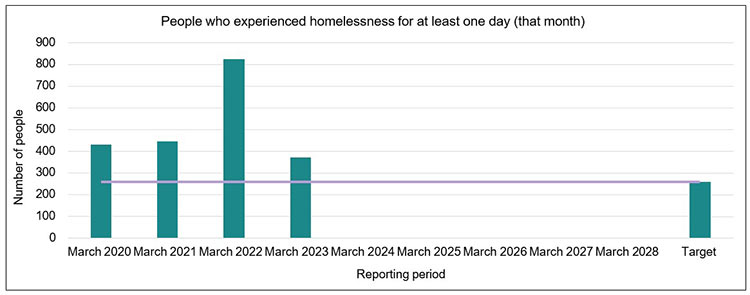
Context for outcome #1 (monthly):
Please provide context about your results, as applicable.
In this reporting year, Peel started to enforce the By-Name List’s 90-day inactivity policy as required by the Ministry. This led to inactivating 1392 clients from Sept 2022 to March 2023 as their last contact date exceeded the 90-day threshold. This resulted in a decrease of 452 people from March 2022 to March 2023.
Was the federal standard for calculating this outcome used (see Annex A)?
Yes.
Outcome #2: Fewer people were newly identified (new inflows to homelessness are reduced)
People who were newly identified (that month).
| March 2020 | March 2021 | March 2022 | March 2023 | March 2024 | March 2025 | March 2026 | March 2027 | March 2028 | Target |
|---|---|---|---|---|---|---|---|---|---|
| 27 | 22 | 11 | 68 | – | – | – | – | – | 16 |
People who were newly identified (that month) image graph.
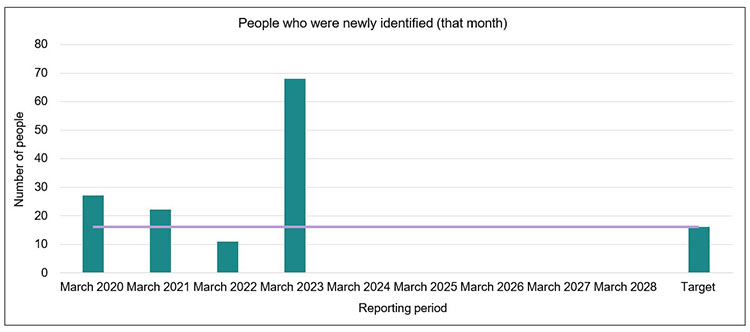
Context for outcome #2 (monthly):
Please provide context about your results, as applicable.
By-Name List Service Provider engagement significantly increased in 2022-23, which led to a steady increase of new client referrals from Access Points. This was accomplished through various training sessions, contract management, and relationship building within our Coordinated Access System. Growing homelessness and shelter use continue to be an issue in our community.
Outcome #3: Fewer people return to homelessness (returns to homelessness are reduced)
Returns to homelessness (that month).
| March 2020 | March 2021 | March 2022 | March 2023 | March 2024 | March 2025 | March 2026 | March 2027 | March 2028 | Target |
|---|---|---|---|---|---|---|---|---|---|
| 0 | 2 | 0 | 1 | – | – | – | – | – | 0 |
Returns to homelessness (that month) image graph.
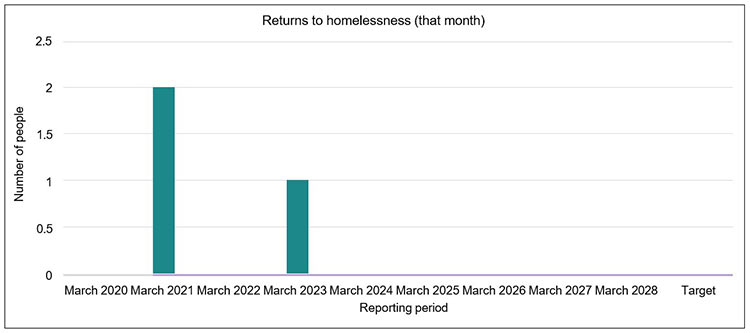
Context for outcome #3 (monthly):
Please provide context about your results, as applicable.
N/A.
Was the federal standard for calculating this outcome used (see Annex A)?
Yes.
Outcome #4: Fewer Indigenous peoples experience homelessness (Indigenous homelessness is reduced)
Indigenous peoples who experienced homelessness for at least one day (that month).
| March 2020 | March 2021 | March 2022 | March 2023 | March 2024 | March 2025 | March 2026 | March 2027 | March 2028 | Target |
|---|---|---|---|---|---|---|---|---|---|
| 7 | 8 | 19 | 11 | – | – | – | – | – | 5 |
Indigenous peoples who experienced homelessness for at least one day (that month) image graph.
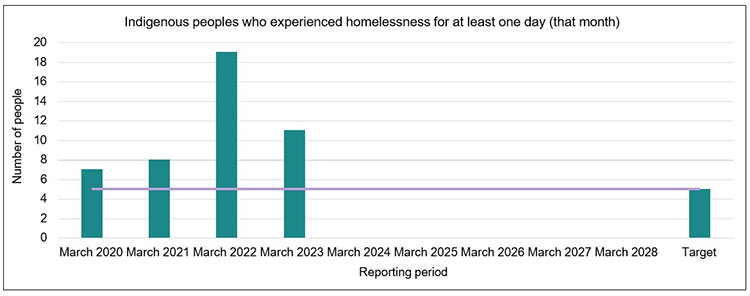
Context for outcome #4 (monthly):
Please provide context about your results, as applicable.
N/A
Was the federal standard for calculating this outcome used (see Annex A)?
Yes.
Outcome #5: Fewer people experience chronic homelessness (chronic homelessness is reduced)
People who experienced chronic homelessness for at least one day (that month).
| March 2020 | March 2021 | March 2022 | March 2023 | March 2024 | March 2025 | March 2026 | March 2027 | March 2028 | Target |
|---|---|---|---|---|---|---|---|---|---|
| 414 | 414 | 746 | 200 | – | – | – | – | – | 207 |
People who experienced chronic homelessness for at least one day (that month) image graph.
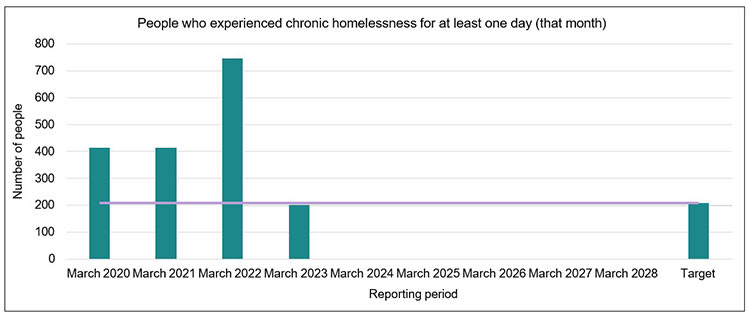
Context for outcome #5 (monthly):
Please provide context about your results, as applicable.
In this reporting year, Peel started to enforce the By-Name List’s 90-day inactivity policy, as required by the Ministry. This led to inactivating 1392 clients from Sept 2022 to March 2023 as their last contact date exceeded the 90-day threshold. This resulted in a decrease of 546 people from March 2022 to March 2023.
Was the federal standard for calculating this outcome used (see Annex A)?
Yes.
Section 4. Community-level outcomes and targets – annual
Outcome #1: Fewer people experience homelessness (homelessness is reduced overall)
People who experienced homelessness for at least one day (that year).
| 2019-20 | 2020-21 | 2021-22 | 2022-23 | 2023-24 | 2024-25 | 2025-26 | 2026-27 | 2027-28 | Target |
|---|---|---|---|---|---|---|---|---|---|
| 537 | 549 | 913 | 1531 | – | – | – | – | – | 441 |
People who experienced homelessness for at least one day (that year) image graph.
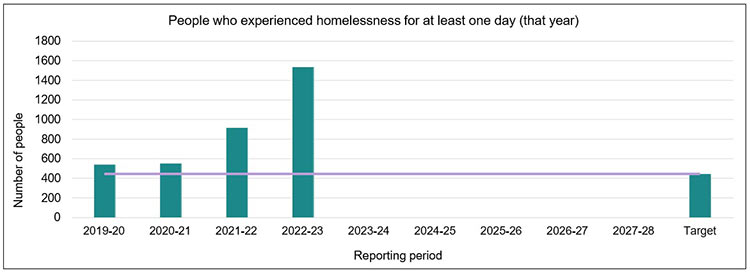
Context for outcome #1 (annual):
Please provide context about your results, as applicable.
By-Name List Service Provider engagement significantly increased in 2022-23, which led to a steady increase of new client referrals from Access Points. This was accomplished through various training sessions, contract management, and relationship building within our Coordinated Access System. Growing homelessness and shelter use continue to be an issue in our community.
Was the federal standard for calculating this outcome used (see Annex A)?
Yes.
Outcome #2: Fewer people were newly identified (new inflows to homelessness are reduced)
People who were newly identified (that year).
| 2019-20 | 2020-21 | 2021-22 | 2022-23 | 2023-24 | 2024-25 | 2025-26 | 2026-27 | 2027-28 | Target |
|---|---|---|---|---|---|---|---|---|---|
| 250 | 114 | 466 | 737 | – | – | – | – | – | 195 |
People who were newly identified (that year) image graph.
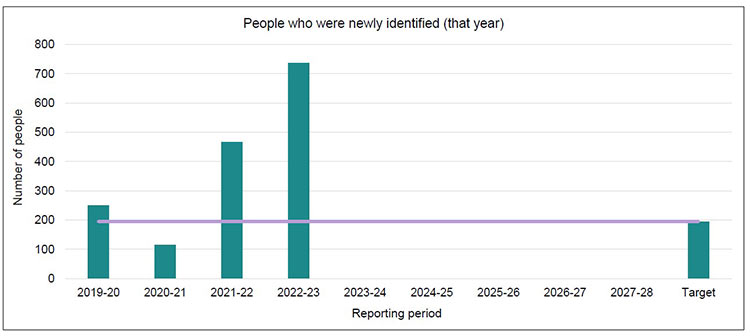
Context for outcome #2 (annual):
Please provide context about your results, as applicable.
By-Name List Service Provider engagement significantly increased in 2022-23, which led to a steady increase of new client referrals from Access Points. This was accomplished through various training sessions, contract management, and relationship building within our Coordinated Access System. Growing homelessness and shelter use continue to be an issue in our community.
Was the federal standard for calculating this outcome used (see Annex A)?
Yes.
Outcome #3: Fewer people return to homelessness (returns to homelessness are reduced)
Returns to homelessness (that year).
| 2019-20 | 2020-21 | 2021-22 | 2022-23 | 2023-24 | 2024-25 | 2025-26 | 2026-27 | 2027-28 | Target |
|---|---|---|---|---|---|---|---|---|---|
| 6 | 5 | 3 | 7 | – | – | – | – | – | 2 |
Returns to homelessness (that year) image graph.
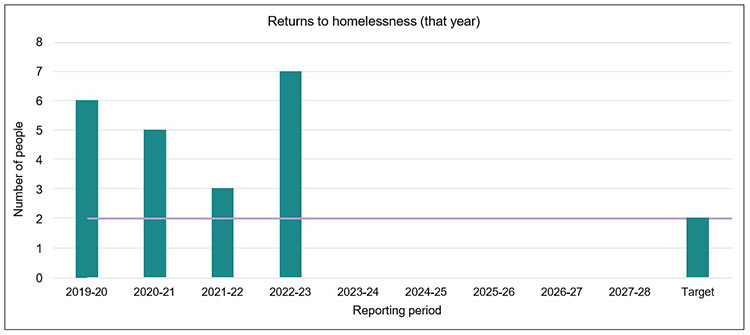
Context for outcome #3 (annual):
Please provide context about your results, as applicable.
By-Name List Service Provider engagement significantly increased in 2022-23, which led to a steady increase of new client referrals from Access Points. This was accomplished through various training sessions, contract management, and relationship building within our Coordinated Access System. Growing homelessness and shelter use continue to be an issue in our community.
Was the federal standard for calculating this outcome used (see Annex A)?
Yes.
Outcome #4: Fewer Indigenous peoples experience homelessness (Indigenous homelessness is reduced)
Indigenous peoples who experienced homelessness for at least one day (that year).
| 2019-20 | 2020-21 | 2021-22 | 2022-23 | 2023-24 | 2024-25 | 2025-26 | 2026-27 | 2027-28 | Target |
|---|---|---|---|---|---|---|---|---|---|
| 26 | 26 | 20 | 35 | – | – | – | – | – | 13 |
Indigenous peoples who experienced homelessness for at least one day (that year) image graph.
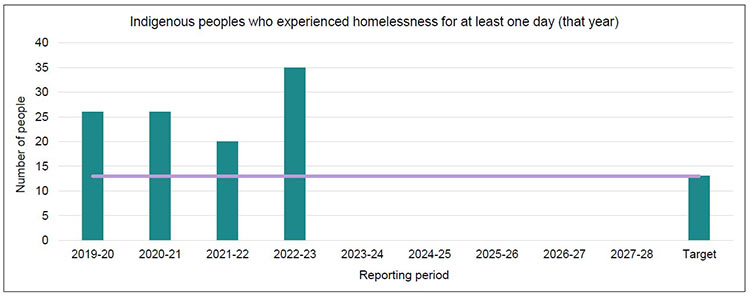
Context for outcome #4 (annual):
Please provide context about your results, as applicable.
N/A.
Was the federal standard for calculating this outcome used (see Annex A)?
Yes.
Outcome #5: Fewer people experience chronic homelessness (chronic homelessness is reduced)
People who experienced chronic homelessness for at least one day (that year).
| 2019-20 | 2020-21 | 2021-22 | 2022-23 | 2023-24 | 2024-25 | 2025-26 | 2026-27 | 2027-28 | Target |
|---|---|---|---|---|---|---|---|---|---|
| 463 | 513 | 833 | 1230 | – | – | – | – | – | 231 |
People who experienced chronic homelessness for at least one day (that year) image graph.
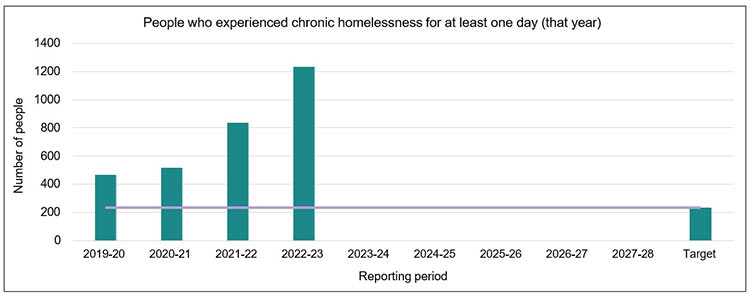
Please provide context about your results, as applicable.
By-Name List Service Provider engagement significantly increased in 2022-23, which led to a steady increase of new client referrals from Access Points. This was accomplished through various training sessions, contract management, and relationship building within our Coordinated Access System. Growing homelessness and shelter use continues to be an issue in our community.
Was the federal standard for calculating this outcome used (see Annex A)?
Yes.





